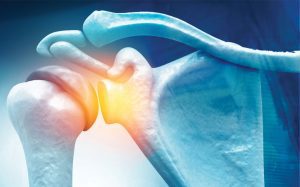

If you’re biking and your tire gets punctured by a sharp object, you know that your time is limited before it completely goes flat, and you’re riding on the rim with an increased risk of crashing. Logically, the best thing to do is to fix the flat. When it comes to shoulder injuries and tears, these are unfortunately a common disorder that many people try to ignore and magically wish away the pain or mask it with pain medications. If left untreated, the injury will progress.
In some cases, rotator cuff tears can be maintained non-surgically with anti-inflammatory medication, steroid injections, and physical therapy, and in some cases with biologics (PRP and stem cells) but tears typically do not heal on their own, so the goal of non-surgical treatment is to relieve pain and restore strength, but limited range of motion may continue to be an issue, in most cases.
If the tear is repairable, an orthopedic surgeon can perform an arthroscopic procedure, but the tear needs to be tended to quickly. If left untreated, the ability to repair and have an optimal outcome becomes more challenging.
In some cases, individuals might find it difficult or impossible to move their arms. If the shoulder injury is severe, a total shoulder replacement might be necessary. With total replacement, the outcomes are generally excellent with marked improvement in pain and possibly range-of-motion, significantly improving the patients’ quality of life.
The most common reasons for shoulder replacement surgery are due to the degenerative effects of arthritis and rotator cuff tears. Age-related degeneration of the joint and rotator cuff is a common issue. When patients struggle through the pain and put off treatment, secondary arthritis develops, causing even more degeneration, impingement and progressively increases pain.
Dr. Christopher Sforzo and Dr. Christopher Dillingham (of Sforzo | Dillingham | Stewart Orthopedics + Sports Medicine) are experts in shoulder repair and offer comprehensive protocols to get their patients back to living and enjoying their lives again with personalized, rehabilitative guidance. Depending on the severity of the tear, they use three techniques for rotator cuff repair: arthroscopic, mini-open repair, and traditional open repair.
Surgical treatment
Arthroscopic Repair – Arthroscopic repair is done with small incisions (less than 1 cm), and the repair is accomplished via a small camera and monitor that the surgeon uses to view the shoulder injury. This is a more recent development in treatment of rotator cuff tears, and not all surgeons can treat tears by this method. The surgery to perform the rotator cuff repair generally lasts between one and two hours.
Open Repair – A larger incision of 6-10 centimeters allows the surgeon to visualize the torn tendon directly, and to repair the area through the incision with unrestricted access. Healing time is increased with this method due to the larger incision.
Mini-Open Repair – The mini-open method of repairing a rotator cuff involves both the use of an arthroscope, and a short incision to get access to torn tendon. By using the arthroscope, the surgeon can also look into the shoulder joint to clean out any damaged tissue or bone spurs. The incision is about 3-4 cm, and the recovery is somewhat less involved than the open cuff repair.
Recovery
Length of recovery will depend on several factors, including your level of strength before the operation and the severity of the rotator cuff disease/tear. For rehabilitation following a subacromial decompression, patients are placed in a shoulder sling following surgery, but they can begin shoulder motion quickly. Strengthening can begin within a few weeks, and sports can resume after the swelling has subsided. However, after the rotator cuff is repaired, physical therapy begins more gradually and with caution. Initially, the therapy is gentle so as not to affect the rotator cuff repair. Within four to six weeks, more active lifting with the arm begins. Approximately eight to 10 weeks after the rotator cuff repair, physical therapy will become more intense in an effort to strengthen the rotator cuff muscles. Complete recovery usually requires at least four to six months.
Sforzo | Dillingham | Stewart Orthopedics + Sports Medicine are everything healthcare should be, and along with their elite expertise, they put their patient’s needs first above all else.
Orthopedic injury and degenerative disorders are common conditions that millions of patients face. Whether your orthopedic condition needs surgery, minimally invasive repair, or regenerative medicine, choosing an orthopedic surgeon should not be something that is taken lightly. Ensuring the physician you select has the credentials and experience necessary is essential, and when it comes to healing your body, improving range-of-motion, functionality, and comfort level finding the best orthopedic surgeon is critical.
You have a choice when deciding on an orthopedic surgeon. It’s essential for patients to do their research, look at real reviews and patient testimonials, and most importantly, to go with a physician or group that has the experience level and training necessary to improve their condition, restore their joints, and get them back to living the life they deserve.
Board certification and fellowshipped-trained doctors are the elite in the orthopedic industry. Their training, skills, and experience are superior, and it is a critical factor to consider when choosing an orthopedic surgeon.
Please call 941-378-5100 to schedule your appointment or visit www.sforzodillingham.com for more information.
Christopher R. Sforzo, M.D. is a board-certified orthopedic surgeon and fellowship-trained in hand and upper extremity surgery. He provides expert care in the treatment of problems involving the shoulder, arm, elbow, forearm, wrist, and hand. Including, carpal tunnel syndrome, joint replacement, fracture and tendon repair.
Christopher L. Dillingham, M.D. is a board-certified orthopedic surgeon and fellowship-trained in hand, shoulder, and arm surgery. He is an expert in the treatment of problems with rotator cuff disorders, carpal tunnel syndrome and nerve injury, joint replacement, arthritis surgery, fracture repair, tendon repair and total reverse shoulder surgery.
Charles E. Stewart, M.D. is a Johns Hopkins fellowship-trained and board-certified orthopedic surgeon specializing in adult complex reconstruction of the lower extremity. His specialties include lower extremity sports injuries, meniscal injuries, ACL reconstruction, partial knee replacement, total hip and knee arthroplasty (replacement), as well as, the reconstruction of failed hip and knee arthroplasties, and complete fracture care.
Philip A. Meinhardt, M.D. is a board-certified orthopedic surgeon and fellowship-trained spine surgeon. He specializes in adult spinal surgeries, including reconstruction of spinal deformities, minimally invasive/microscopic spinal procedures, decompression, spinal instrumentation, fusion procedures, and microscopic cervical disc replacements.
……………………………………………………….
When you choose Sforzo | Dillingham | Stewart Orthopedics + Sports Medicine, you can rest assured that you will be treated with respect, given the opportunity to ask questions, your options will be explained in detail, and you will be in the hands of experienced surgeons with the utmost integrity, receiving optimal care.
 Southwest Florida's Health and Wellness Magazine Health and Wellness Articles
Southwest Florida's Health and Wellness Magazine Health and Wellness Articles

